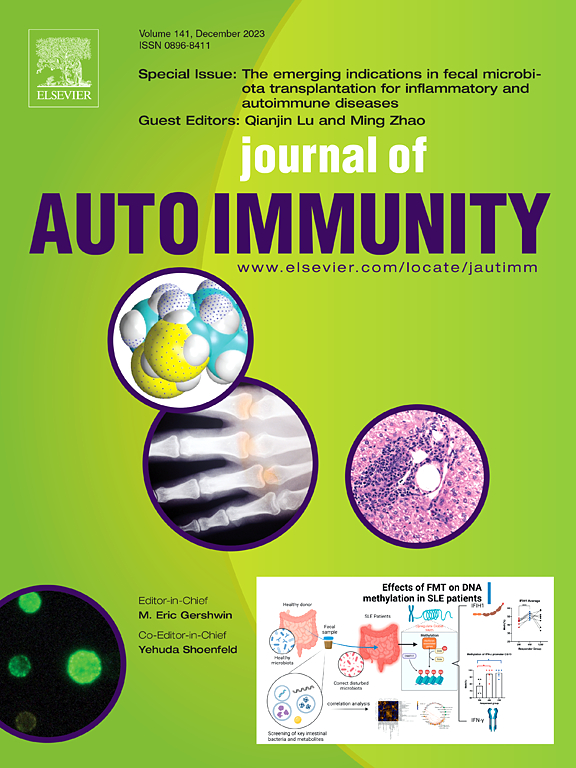Selective disruption of Traf1/cIAP2 interaction attenuates inflammatory responses and rheumatoid arthritis
IF 7
1区 医学
Q1 IMMUNOLOGY
引用次数: 0
Abstract
Objectives
Tumor necrosis factor receptor-associated factor 1 (TRAF1) is an immune signaling adapter protein linked to increased susceptibility to rheumatoid arthritis (RA). TRAF1 has dual roles in regulating NF-κB and MAPK signaling: it promotes signaling through its association with cellular inhibitor of apoptosis 2 (cIAP2) downstream of certain tumor necrosis factor receptor (TNFR) family members but inhibits Toll-like receptor (TLR) signaling by limiting linear ubiquitination of key signaling proteins. In this study, we investigated whether selectively targeting TRAF1/cIAP2 interaction would lower inflammation and reduce severity of RA.
Methods
We employed CRISPR/Cas9-mediated mediated gene editing to modify TRAF1 and specifically abrogate its interaction with cIAP2 in human macrophage cell lines and in mice. Biochemical studies were then employed to assess inflammatory signaling and cytokine production in gene edited macrophages. The collagen antibody-induced arthritis (CAIA) model of RA was used to trigger joint inflammation in mice.
Results
We identify a critical mutation in TRAF1 (V203A in humans, V196A in mice) that disrupts its interaction with cIAP2, leading to a significant reduction in TLR signaling and downstream inflammation in human and murine macrophages. We demonstrate that TRAF1 is recruited to the TLR4 complex and is indispensable for the recruitment of cIAP2, facilitating TAK1 phosphorylation and the activation of NF-κB and MAPK signaling pathways. Remarkably, mice harboring the TRAF1 V196A mutation are protected from LPS-induced septic shock and exhibit markedly reduced joint inflammation and disease severity in the CAIA model of RA.
Conclusion
These findings reveal a previously unrecognized and crucial role for the TRAF1/cIAP2 axis in promoting inflammation and offer a promising foundation for the development of novel therapeutic strategies for inflammatory conditions, such as RA.

选择性破坏Traf1/cIAP2相互作用可减轻炎症反应和类风湿关节炎。
目的:肿瘤坏死因子受体相关因子1 (TRAF1)是一种与类风湿关节炎(RA)易感性增加相关的免疫信号转导蛋白。TRAF1在调节NF-κB和MAPK信号传导中具有双重作用:它通过与某些肿瘤坏死因子受体(TNFR)家族成员下游的细胞凋亡抑制剂2 (cIAP2)关联促进信号传导,但通过限制关键信号蛋白的线性泛素化抑制toll样受体(TLR)信号传导。在这项研究中,我们研究了选择性靶向TRAF1/cIAP2相互作用是否会降低炎症和减轻RA的严重程度。方法:采用CRISPR/ cas9介导的介导基因编辑技术,在人巨噬细胞系和小鼠中修饰TRAF1,特异性地消除其与cIAP2的相互作用。然后采用生化研究来评估基因编辑巨噬细胞的炎症信号传导和细胞因子产生。采用胶原抗体诱导关节炎(CAIA)模型诱发小鼠关节炎症。结果:我们在TRAF1(人类为V203A,小鼠为V196A)中发现了一个关键突变,该突变破坏了其与cIAP2的相互作用,导致人类和小鼠巨噬细胞中TLR信号和下游炎症的显著减少。我们证明TRAF1被招募到TLR4复合体中,并且对于cIAP2的招募是必不可少的,促进TAK1磷酸化和NF-κB和MAPK信号通路的激活。值得注意的是,在RA的CAIA模型中,携带TRAF1 V196A突变的小鼠可以免受lps诱导的脓毒性休克的影响,并显着降低关节炎症和疾病严重程度。结论:这些发现揭示了TRAF1/cIAP2轴在促进炎症中的重要作用,为开发新的炎症治疗策略(如RA)提供了有希望的基础。
本文章由计算机程序翻译,如有差异,请以英文原文为准。
求助全文
约1分钟内获得全文
求助全文
来源期刊

Journal of autoimmunity
医学-免疫学
CiteScore
27.90
自引率
1.60%
发文量
117
审稿时长
17 days
期刊介绍:
The Journal of Autoimmunity serves as the primary publication for research on various facets of autoimmunity. These include topics such as the mechanism of self-recognition, regulation of autoimmune responses, experimental autoimmune diseases, diagnostic tests for autoantibodies, as well as the epidemiology, pathophysiology, and treatment of autoimmune diseases. While the journal covers a wide range of subjects, it emphasizes papers exploring the genetic, molecular biology, and cellular aspects of the field.
The Journal of Translational Autoimmunity, on the other hand, is a subsidiary journal of the Journal of Autoimmunity. It focuses specifically on translating scientific discoveries in autoimmunity into clinical applications and practical solutions. By highlighting research that bridges the gap between basic science and clinical practice, the Journal of Translational Autoimmunity aims to advance the understanding and treatment of autoimmune diseases.
 求助内容:
求助内容: 应助结果提醒方式:
应助结果提醒方式:


